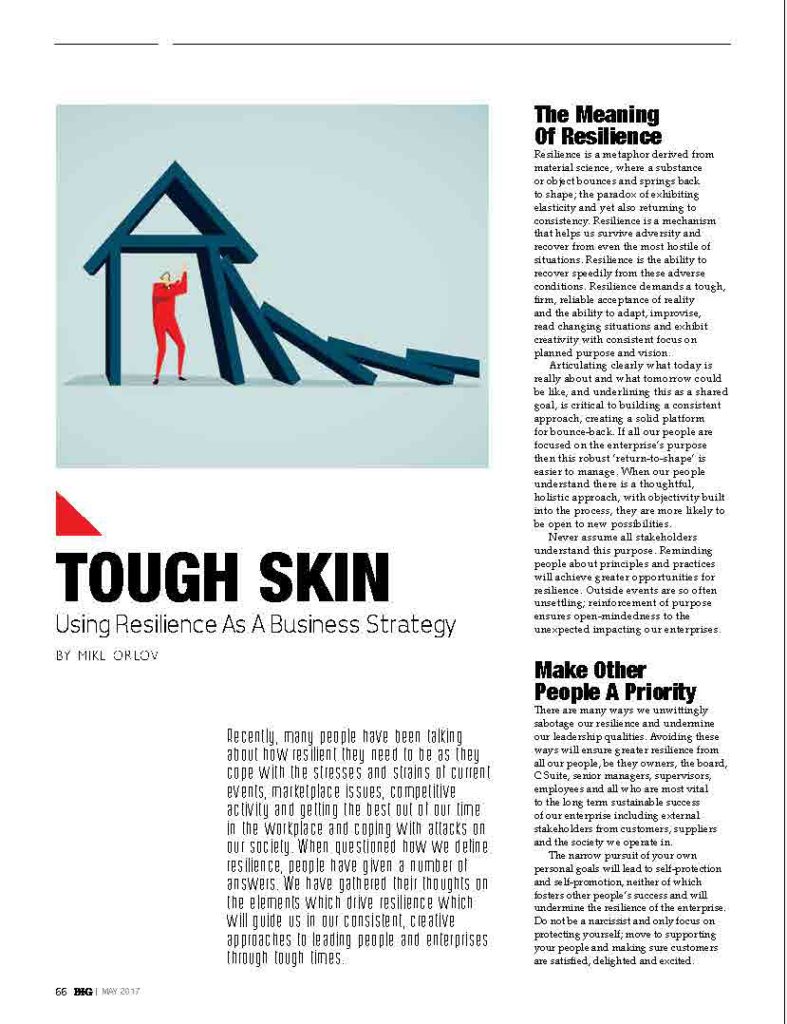
 Resilience as a Strategy
Resilience as a Strategy
Recently, many people have been talking about how resilient they need to be as they cope with the stresses and strains of current events, marketplace issues, competitive activity and getting the best out of our time in the workplace and coping with attacks on our society. When questioned how we define resilience, people have given a number of answers. We have gathered their thoughts on the elements which drive resilience which will guide us in our consistent, creative approaches to leading people and enterprises through tough times.
Resilience is a metaphor derived from material science, where a substance or object bounces and springs back to shape; the paradox of exhibiting elasticity and yet also returning to consistency. Resilience is a mechanism that helps us survive adversity and recover from even the most hostile of situations. Resilience is the ability to recover speedily from these adverse conditions. Resilience demands a tough, firm reliable acceptance of reality and the ability to adapt, improvise, read changing situations and exhibit creativity with consistent focus on planned purpose and vision.
Articulating clearly what today is really about and what tomorrow could be like, and underlining this as a shared goal, is critical to building a consistent approach, creating a solid platform for bounce-back. If all our people are focused on the enterprise’s purpose then this robust ‘return-to-shape’ is easier to manage. When our people understand there is a thoughtful, holistic approach, with objectivity built into the process, they are more likely to be open to new possibilities.
Never assume all stakeholders understand this purpose. Reminding people about principles and practices will achieve greater opportunities for resilience. Outside events are so often unsettling; reinforcement of purpose ensures open-mindedness to the unexpected impacting our enterprises.
There are many ways we unwittingly sabotage our resilience and undermine our leadership qualities. Avoiding these ways will ensure greater resilience from all our people, be they owners, the board, C Suite, senior managers, supervisors, employees and all who are most vital to the long term sustainable success of our enterprise including external stakeholders from customers, suppliers and the society we operate in.
The narrow pursuit of your own personal goals will lead to self-protection and self-promotion, neither of which fosters other people’s success and will undermine the resilience of the enterprise. Do not be a narcissist and only focus on protecting yourself; move to supporting your people and making sure customers are satisfied, delighted and excited.
Making other people a priority is perhaps the most challenging platform to achieve successful resilience in our organizations. Of course we have personal goals but those who work towards generous outcomes will ensure greater resilience and survivability. Almost all great leaders have a strong team helping provide perspective and aiding resilience.
You need to develop the ability to ask yourself tough questions and answer honestly. Be true to your values, anchored in an ethical approach, be honest and take responsibility; others will follow your lead. The more people you watch-over, the greater your motivation and the stronger the reason, for effectively bouncing back from unforeseen impacts on the enterprise demanding resilience from all who care for its success.
You need to do whatever is necessary to get back on course. With resilience, you are able to look at a situation and creatively determine the best way out of tough unforeseen circumstances. You are enterprising in your approach toward starting-over and you recognize failure is not a negative but a way to learn for future activity.
Resilience demands a definite but patient response. Like risk-aversion, patience is a much under-valued leadership trait. The main ingredients of patience are discipline and hope. Patience helps us uncover the root cause of problems. Patience can however undermine our resilience by persuading us to keep our heads down and not act; ensure you are decisive after your patient review of what is going on.
A sense of humor is important too. Of course we have to take negative impacts on our organizations seriously and you’ve got to take goals seriously, but we have to be able to laugh at ourselves and our situation. Laughter connects us with others and we gain a sense of interconnectedness and belonging, stimulating greater resilience through the enterprise.
People who have overcome hardships and tremendous obstacles are aware there is so much which happens over which we have no control. All we can control is our reaction to life and through our reactions we influence what happens around us. In our enterprises, our responsibility is to stimulate positive reactions ensuring we get the best-possible bounce-back taking us back on track to our purpose and vision.
Share your purpose, be a community builder, collaborate with others, be ethically driven, stimulate trust, be patient, analyze, decide on what to do in conjunction with others, be agile and stimulate a high-performance approach knowing you and your people will have to handle difficult situations.
